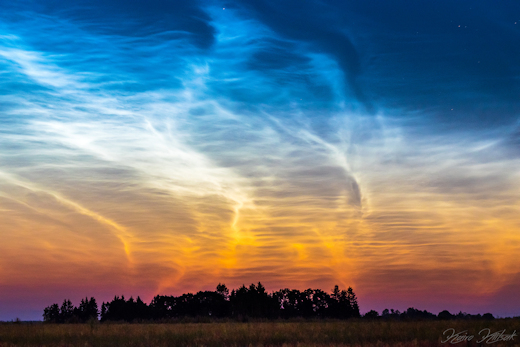This summer, something strange has been happening in the mesosphere.
The mesosphere is a layer of the atmosphere so high that it almost touches space. In the rarefied air 83 km above Earth’s surface, summertime wisps of water vapor wrap themselves around specks of meteor smoke. The resulting swarms of ice crystals form noctilucent clouds (NLCs), which can be seen glowing in the night sky at high latitudes.
And, no, that’s not the strange thing.
Northern sky watchers have grown accustomed to seeing these clouds in recent years. They form in May, intensify in June, and ultimately fade in July and August. This year, however, something different happened. Instead of fading in late July, the clouds exploded with unusual luminosity. Kairo Kiitsak observed this outburst on July 26th from Simuna, Estonia:
“It was a mind-blowing display,” says Kiitsak. “The clouds were visible for much of the night, rippling brightly for at least 3 hours.”
Other observers saw similar displays in July and then, in August, the clouds persisted. During the first half of August 2018, reports of NLCs to Spaceweather.com have tripled compared to the same period in 2017. The clouds refuse to go away.
Researchers at the University of Colorado may have figured out why. “There has been an unexpected surge of water vapor in the mesosphere,” says Lynn Harvey of Colorado’s Laboratory for Atmospheric and Space Physics (LASP). This plot, which Harvey prepared using data from NASA’s satellite-based Microwave Limb Sounder (MLS) instrument, shows that the days of late July and August 2018 have been the wettest in the mesosphere for the past 11 years:

“July went out like a lion!” says Harvey.
In addition to being extra wet, the mesosphere has also been a bit colder than usual, according to MLS data. The combination of wet and cold has created favorable conditions for icy noctilucent clouds.
Harvey and her colleagues are still working to understand how the extra water got up there. One possibility involves planetary wave activity in the southern hemisphere which can, ironically, boost the upwelling of water vapor tens of thousands of miles away in the north. The phenomenon could also be linked to solar minimum, now underway. It is notable that the coldest and wettest years in the mesosphere prior to 2018 were 2008-2009–the previous minimum of the 11-year solar cycle.
Stay tuned for updates and, meanwhile, be alert for NLCs.
Source: Spaceweather.com


































Leave a Comment
You must be logged in to post a comment.